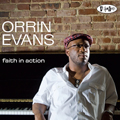 www.somethingelsereviews.com
www.somethingelsereviews.com
by Pico
In the promo video below, pianist Orrin Evans performs the first cut from his new album Faith In Action, and the camera ever so slyly captures a picture of Thelonious Monk in the background. The subliminal advertising is undoubtedly intended to suggest that Evans’ playing style is inspired by one of the all-time great composer and piano players of jazz. However, the message is made more bluntly by his playing style. The direct way Evans attacks the keys, the playful way his right hand plays a cat and mouse game with the left, and an eccentric portrayal of the blues tradition, Evans effectively evokes the specter of the odd pioneer of modern jazz.
And this is just one facet of the ever-expansive range of Evans.
Orrin Evans looks and sounds fresh and young, something you might not still expect for someone who—by my best estimate—just last Tuesday released his 10th album. The Philly-raised talent was part of the mini-explosion of straight-ahead jazz musicians who emerged in the 1990s. During this time and into the millennium, Evans learned from luminaries like Kenny Barron, Duane Eubanks and saxophonist Bobby Watson. Faith In Action, in fact, honors his old boss Watson by re-interpreting Watson’s tunes, of which fill up half of this ten-song collection.
These renderings are not done with saxophone like the originals: Evans sticks with a trio format nearly all the way through, employing the services of Luques Curtis on bass and the ever-ubiquitous Nasheet Waits drums for all but three of the cuts; drummers Rocky Bryant and Gene Jackson fill in for these songs. Having played for Watson for a number of years, Evans was able to identify several Watson compositions that haven’t been covered much by others—if at all–but sounds like standards in his hands. The resulting record is brisk, loose-but-not-too-loose and unwaveringly swings.
After “Don’t Call Me Wally,” that Evans original inspired by Monk, the leader dives into three Watson tunes in a row. A fine interpretation of the title song is highlighted by Evans’ solo being closely traced by Waits’ tom-tom work. “Wheel Within A Wheel” was a favorite of Art Blakey when Watson served as the musical director in Blakey’s Jazz Messengers in the late seventies-early eighties. This waltzing number gets going with a brief but tasteful solo from Bryant, then some equally graceful playing from Evans, who pours on the passion but never overplays the song. Curtis follows up with a Latin-inspired solo, accentuated by palmas (handclaps). A highlight for all three players. For “Appointment In Milano,” Evans lays down some muscular McCoy Tyner chord voicings before he stretches his hard bop almost all the way to out territory. His rapport with Waits on the ending breakdown section is telepathic as well as scorching.
Curtis contributes some discreet bass lines that bolster Evans’ own piano lines on the introspective “Matthew’s Song.” Watson’s “Beattitudes” is a display of Evans’ expressive playing in a solo setting. After three more quality selections by Evans and Watson, the set concludes with “Why Not,” a song first recorded on Watson’s Live And Learn album (2002) but composed by Evans’ wife Dawn Warren. It’s an elegant composition that is firmly anchored by a walking bass and shaped by a singing melody.
As for the filler songs in this album, well, there aren’t any. Orrin Evans locates the under appreciated beauty in Bobby Watson’s compositions and throws in some of his own that are clearly inspired by his former mentor. Remarked Watson, “Orrin owns this music now. If no one else ever records my music again in my lifetime, I am truly blessed to have had Orrin take my music to places I never imagined, and make it his own.”

 Jared Gold: Supersonic (Posi-Tone Records)
Jared Gold: Supersonic (Posi-Tone Records)

